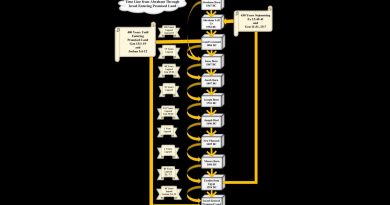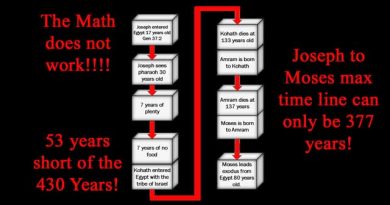Astronomical Timeline Strengthens the Bible
The Bible’s chronology is more verifiable than all other historical chronologies. The Bible provides the first people’s names created by God and continues a running genealogy to Jesus.
Historians, however, still disagree on some chronology durations found within the Bible. Some historians argue that years are missing, so they pack hundreds of years into the timeline when there should only be a few. Other historians claim the reported hundreds of years that the Bible gives are too much, so they crush it into a few years. This book will establish the most accurate Bible timeline possible using a Bible-first approach and then be supported by other timelines—but not changed by them.
A chronology breathes life into civilizations from long ago. These cultures, often merely mentioned, are just a group of people. However, associating a family chronology places life within that society. It is one thing to say a culture exists; it is another to give the ancestral history from its patriarch to any given point.
A perpetual chronology brings life into that ancient society. When viewed within a particular culture, this tracking of life and time gives a dimension of time to that society. This time dimension allows for stories to be told and lives to be lived. When looking at tombstones, the dash between the birth date and the death date represents a person’s life and deeds. Establishing a chronology of key individuals—dashes, if you will, in history—can bring ancient cultures and societies back to life and learn from them.
The chronology timeline of a society allows for the establishment of a world timeline. Once the timeline of various societies has been established, they can be overlapped. If done correctly, the overlapping will all line up, giving the ability to see what happened in each civilization at any given point in time. The timelines of the civilizations grow more robust and more accurate as society timelines are combined. By finding associations within two cultures, we can bring life to both. One patriarch’s association in one society to a patriarch of another society binds both society’s timelines together. The linking of all societal chronologies into one world chronology allows for an overarching timeline for the world.
The timelines established through chronologies are only as accurate as of the historian’s associations within the chronologies. Ancestral timelines for tribes, regional, and world chronologies are only as good as those making the connections. Several hurdles exist in linking a civilization’s chronology. For instance, the languages may be different, individuals may be known by different names in each culture, and some societies have more gaps in their recorded timelines than others. These variables and more could throw off the timeline by hundreds of years.
Historians must rank each society’s chronological timeline then stack them in the order of their accuracy. An example is if an Egyptian Pharaoh is proved to be the one who opposed God and Moses during the Exodus. In such a case, which method should be employed to determine the exact year in history he opposed God? The most popular option is to go to Egyptian chronology, take the date assigned to the Pharaoh, and apply it to the Exodus. Another option is to take the date assigned within the Bible to the Exodus and apply that to the Egyptian chronology.
The first method starts with a base timeline of the Egyptian culture and then adjusts the Bible to fit that timeline. The second option starts with the Bible as the baseline and adjusts the Egyptian timeline to the biblical timeline. As seen, the historian chooses which chronology to give more weight to: is it the Egyptians or the Israelites? Traditional historians use the Egyptian timeline as the base for their biblical timeline and then place the Israelite timeline on the Egyptian timeline. At first glance, this could appear logical, assuming the historian is picking the most intact and accurate timeline. However, determining which timeline is the most intact and accurate is subjective.
Most secular historians consider the Egyptian timeline to be the most detailed and complete timeline available, going back before the time of Moses. The Egyptian timeline is impressive. However, historians are not in agreement on the duration of several periods of Egyptian history. When surveying the length of time from 1500 BC to now, there is roughly a 100-year discrepancy between the historians’ timelines.
Most timelines have gaps in their historical records. The primary concern with any timeline is unknown or missing lengths of time. Secular historians argue that the Bible timeline is full of gaps, making it less dependable than the Egyptian timeline. In fact, the Bible timeline is complete, surpassing the Egyptian timeline.
Historians look at significant events that transcend cultures to minimize time discrepancies, enabling timeline attachments around that event. When historians know of an event, such as a volcano eruption, they can find the impact of that event upon the various civilizations. The events allow for linking all impacted societies and thus establishing one timeline. The problem, however, is that most historical events are also open to personal opinion as to when they occurred.
Timelines based on personal opinions tend to be less accurate than those based on a mathematically provable chain of events. While combining societal timelines establishes a more reliable timeline, there is still room for opinion on connecting those timelines, introducing a significant opportunity for error. Timelines based on a mathematically provable chain of events remove personal opinion and introduce fact.
The primary method of establishing correct dates involves linking events from timelines that cannot be adjusted. One timeline that cannot be adjusted is astronomical history. Astronomical history can never be changed. Once it was set in motion, it will stay in motion. Astronomical calculations can be run forward and backward at any point in time without changing the results. The astronomical clock is the most incorruptible baseline available to us. Therefore, the Bible and astronomical charts are the most trustworthy timelines known to exist.
Over the last 200 years, astrophysicists have calculated the celestial timeline. The Holy Spirit has blessed us with a calendar in the sky that has no discrepancies. The advancement of physics over the last 200 years has led to breakthroughs in understanding how to calculate this timeline. Physicists have learned how to calculate the earth’s orbit around the sun and the moon around the earth. Physicists have learned that the earth is slowing down. Astrophysicists can model what is in the sky today or 3,000 years in the future or 3,000 years in the past. The astronomical timelines can be considered scientific evidence based on our ability to accurately model any moment in time: present, future, or past.
The Bible timeline provides human history, such as genealogy and information regarding astronomical events. Ancient Israel calculated the beginning of all their months based on the lunar cycle. The astronomical timeline strengthens the biblical timeline, providing exact dates for events such as the rising moon’s locations on the horizon and total solar eclipses that would have impacted Israel. The Bible timeline, when used as the baseline, can be strengthened by overlapping the astronomical timeline onto it.
One significant benefit of overlapping the Bible and astronomical timelines is that it proves the Bible is accurate!
Many Christians have used the astronomical timeline in the past for dating biblical events. Archbishop Ussher, in 1658 AD, made the most comprehensive chronological studies of his time, and within it, he used the word eclipse over 100 times. Several commentators, such as Ellicott’s Commentary on the Bible, mention the idea of solar eclipses being described in the Bible.
Determining when and where Bible events occurred allows for an accurate timeline to be established. For the first time, calculations for days of weeks and solar eclipses can be accurately performed, and when lined up with the Bible, more accurate timelines can be established. Studying the firsthand accounts of Bible events and examining the known natural phenomenon that took place at the same time will shed light and further understanding of the Scripture.
Through a Bible-first approach with secondary inputs, this book will uncover exact biblical dates. The Bible is the primary reference for this book, and any additional input will be taken from Bible scholars, secular historians, and astronomical data. By combining all available resources, an accurate chronology of the Bible will be revealed.



